For today’s truck enthusiasts, the term “small pickup” might seem almost ironic. Modern “compact” trucks have grown considerably, blurring the lines with their full-size counterparts in terms of dimensions and engine power. Looking back, it’s clear that what we consider small today is vastly different from the genuinely compact and economical pickups that populated roads just a few decades ago. 1989 represents a fascinating snapshot in time, a period when the small pickup segment was not just alive, but thriving, offering a plethora of choices for buyers seeking utility without excessive bulk.
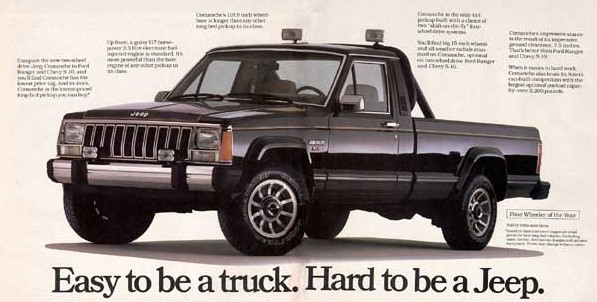 1989 Jeep Comanche front view
1989 Jeep Comanche front view
In 2014, the automotive landscape looked remarkably different. With models like the Chevrolet Colorado and GMC Canyon temporarily absent from the market, the options for truly compact trucks dwindled significantly. Only Honda, Nissan, and Toyota maintained a presence in this shrinking class. The Nissan Frontier, often cited as a “compact” option, stretched to a considerable 220 inches and could weigh in at a hefty 4400 pounds, especially in its long-bed crew-cab configuration.
Fast forward to 1989, and the narrative shifts dramatically. Nissan’s compact offering, then simply known as the Pickup, measured under 190 inches and weighed less than 3200 pounds in its heaviest configuration. This era, a quarter of a century prior, existed before the widespread adoption of crew-cab bodies in the small truck category. In 1989, consumers were spoiled for choice, with no fewer than 11 distinct models vying for their attention in the small pickup segment. Let’s take a nostalgic journey back to this era and explore the diverse range of Small Pickups that defined the roads of 1989. If you have personal experiences with these honest and hardworking machines, we encourage you to share your stories!
Chevrolet S-10: The American Standard
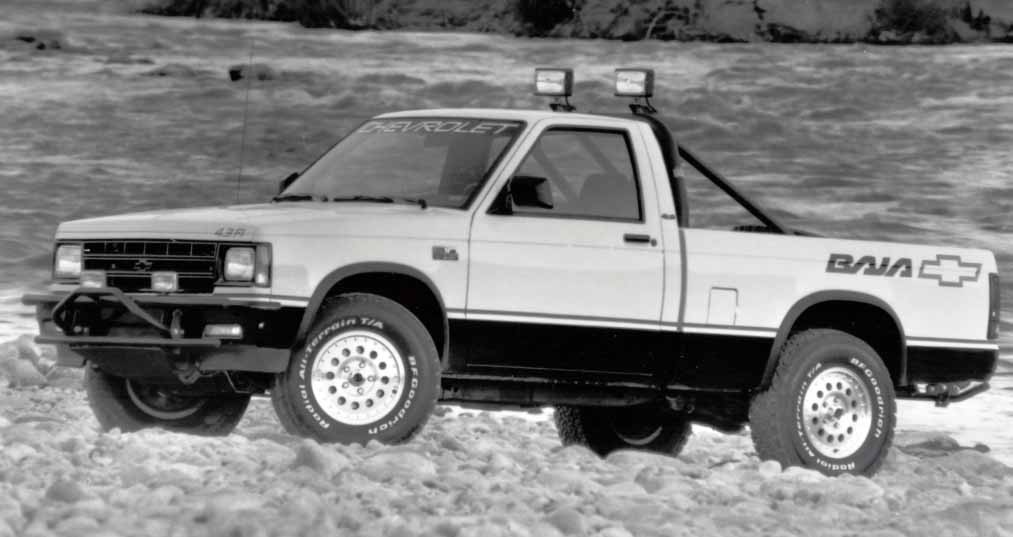 1989 Chevrolet S-10 front quarter view in silver
1989 Chevrolet S-10 front quarter view in silver
The Chevrolet S-10 was a cornerstone of the small pickup market in 1989, a true American workhorse. Priced affordably with a base of $7874, the S-10 offered a practical and no-nonsense approach to trucking. The standard engine was a fuel-efficient 2.5-liter 4-cylinder producing 92 horsepower, adequate for everyday tasks and light hauling. For those needing more grunt, Chevrolet offered two optional V6 engines: a 125-horsepower 2.8-liter and a more potent 160-horsepower 4.3-liter, providing a significant step up in performance and towing capability. A notable upgrade for the 1989 model year was the standardization of rear antilock brakes, enhancing safety and control.
Explore more about the Chevrolet S-10
Dodge Dakota: Bridging the Gap
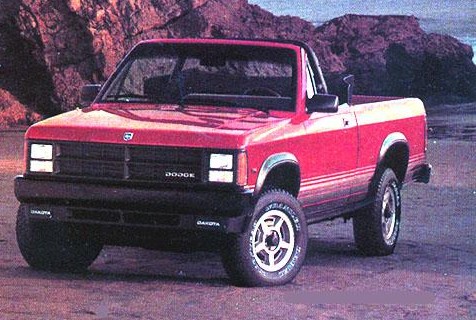 1989 Dodge Dakota side view in red
1989 Dodge Dakota side view in red
The Dodge Dakota carved a unique niche for itself as a slightly larger small pickup, bridging the gap between truly compact models and their bigger brethren. Starting at $7879, the Dakota aimed to offer more capability without sacrificing the maneuverability of a smaller truck. Its base 2.5-liter 4-cylinder engine delivered 100 horsepower. An optional 125-horsepower 3.9-liter V6 provided enhanced power for heavier loads and more demanding driving conditions. Adding a touch of flair to the lineup, Dodge introduced the Dakota Sport convertible in 1989, a unique and open-air take on the pickup truck that remained available until 1991.
Learn more about the Dodge Dakota
Dodge Ram 50: The Mitsubishi Twin
The 1989 Dodge Ram 50, with a base price of $7919, represented a collaborative effort, being assembled by Mitsubishi for Dodge. This meant the Ram 50 was mechanically identical to the Mitsubishi Mighty Max, offering buyers essentially the same truck under different badges. The base engine was a 90-horsepower 2.0-liter 4-cylinder, while an optional 109-horsepower 2.6-liter 4-cylinder offered a modest power increase. This badge-engineered approach allowed Dodge to offer a Japanese-engineered small pickup within their domestic lineup.
Discover used pickup reviews, including Dodge Ram 50
Ford Ranger: A Long-Standing Favorite
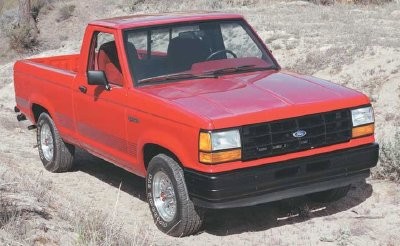 1989 Ford Ranger front view in blue and white
1989 Ford Ranger front view in blue and white
The Ford Ranger was a dominant force in the small pickup segment, and the 1989 model, starting at $8093, continued its reign as a popular choice. Known for its reliability and versatility, the Ranger’s base engine was a 100-horsepower 2.3-liter 4-cylinder. For those seeking more power, a 140-horsepower 2.9-liter V6 was available. The Ranger also catered to those needing more passenger space with the “Supercab” extended-cab version, although this came at a higher price point, starting at $10,749. The Ford Ranger cemented its place as a dependable and adaptable small pickup.
Find out more about the Ford Ranger
GMC S-15: The Upscale Twin
The 1989 GMC S-15, priced slightly higher than its Chevrolet counterpart at $7927, shared almost everything mechanically with the S-10. The base engine was the same 92-horsepower 2.5-liter 4-cylinder, and the same optional V6 engines were available: the 125-horsepower 2.8-liter and the 160-horsepower 4.3-liter. The GMC S-15 aimed to offer a slightly more refined or upscale image compared to the Chevrolet S-10, though the differences were minimal, primarily reflected in subtle styling cues and a slightly higher base price. The “fun fact” highlights this close relationship: for a mere $53 price difference, the S-15 was essentially an S-10 with a GMC badge.
Explore small GMC pickups, including the S-15
Isuzu Pickup: Japanese Import with Disc Brakes
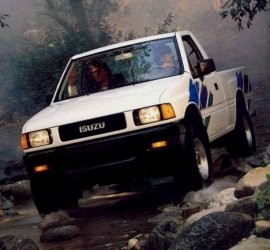 1989 Isuzu Pickup front quarter view in white
1989 Isuzu Pickup front quarter view in white
The 1989 Isuzu Pickup, with a base price of $7908, represented the Japanese influence in the small pickup market. Its base engine was a 96-horsepower 2.3-liter 4-cylinder, and an optional 120-horsepower 2.6-liter 4-cylinder provided a step up in power. A standout feature of the Isuzu Pickup was its standard 4-wheel disc brakes, a relatively advanced feature for a small pickup in this era, offering enhanced braking performance compared to drum brakes. Isuzu carved a niche by offering Japanese reliability and some advanced features in the competitive small pickup segment.
Jeep Comanche: The Off-Road Ready Pickup
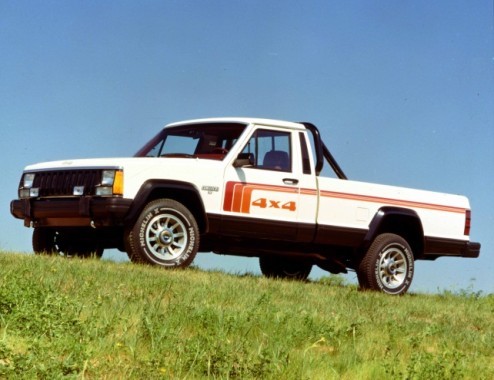 1989 Jeep Comanche angled front view in red on off-road terrain
1989 Jeep Comanche angled front view in red on off-road terrain
The Jeep Comanche, starting at $8111, brought Jeep’s rugged DNA to the small pickup category. Sharing its underpinnings with the Jeep Cherokee, the Comanche offered a unique blend of truck utility and Jeep’s renowned off-road capability. Its base engine was a robust 121-horsepower 2.5-liter 4-cylinder. For serious power, the optional 177-horsepower 4.0-liter 6-cylinder engine was a standout, providing ample torque for off-roading and hauling. The Comanche appealed to buyers seeking a small pickup with genuine off-road credentials and Jeep’s distinctive styling.
Discover more about used Jeeps
Mazda B-Series: Two Flavors of Drivetrain
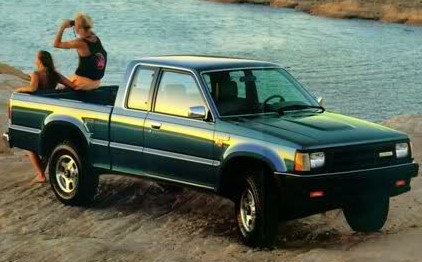 1989 Mazda B-Series front view in red
1989 Mazda B-Series front view in red
The 1989 Mazda B-Series offered two distinct models within its lineup, each with a specific drivetrain configuration. The B2200, starting at $8068, featured an 85-horsepower 2.2-liter 4-cylinder engine and rear-wheel drive only. The B2600, with a 121-horsepower 2.6-liter 4-cylinder, came exclusively with 4-wheel drive. This clear differentiation allowed Mazda to cater to buyers seeking either a fuel-efficient rear-drive small pickup or a more capable 4×4 version, all under the B-Series umbrella.
Explore more about the Mazda B-Series
Mitsubishi Mighty Max: The “Macrocab” Option
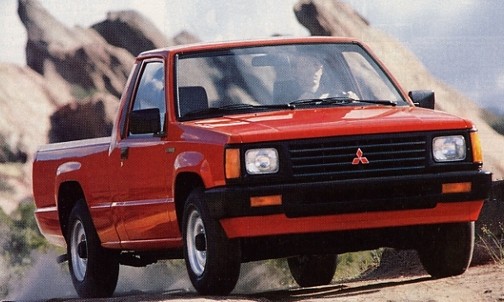 1989 Mitsubishi Mighty Max side view in red
1989 Mitsubishi Mighty Max side view in red
The 1989 Mitsubishi Mighty Max, priced competitively at $7864, offered a range of configurations, including the extended-cab version officially named “Macrocab.” The base engine was a 90-horsepower 2.0-liter 4-cylinder, with an optional 109-horsepower 2.6-liter 4-cylinder available. The Mighty Max, twinned with the Dodge Ram 50, provided a Japanese alternative in the small pickup market, known for its fuel efficiency and compact dimensions. The “Macrocab” extended cab added a degree of practicality for carrying extra gear or occasional passengers.
Learn about used Mitsubishi trucks, including Mighty Max
Nissan “Hardbody” Pickup: Rugged and Feature-Rich
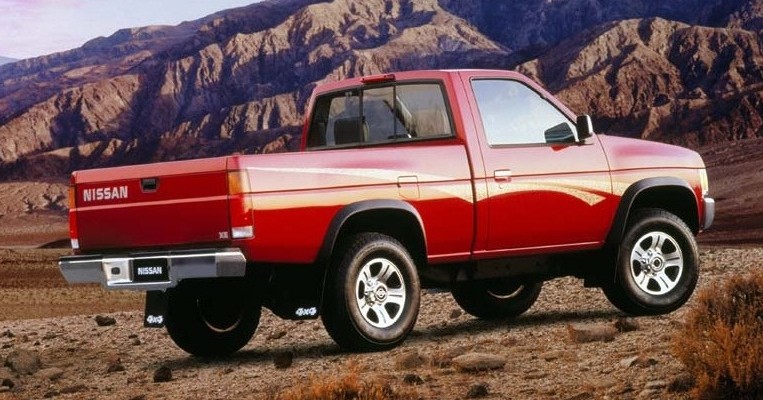 1989 Nissan Hardbody Pickup front quarter view in gray
1989 Nissan Hardbody Pickup front quarter view in gray
The 1989 Nissan “Hardbody” Pickup, starting at a budget-friendly $7799, earned its nickname for its tough and durable styling. Its base engine was a 106-horsepower 2.4-liter 4-cylinder, with an optional 145-horsepower 3.0-liter V6 for added power. The Nissan Pickup stood out for offering features not commonly found in small pickups at the time, such as optional power sliding rear glass and a pop-up sunroof, adding a touch of convenience and open-air enjoyment to the utilitarian segment.
Discover more about compact Nissan pickups
Toyota Pickup: The Powerful Japanese Contender
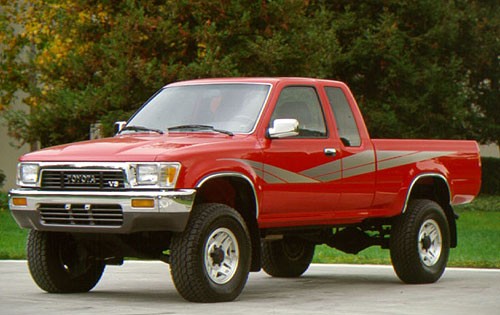 1989 Toyota Pickup front quarter view in red
1989 Toyota Pickup front quarter view in red
The 1989 Toyota Pickup, with a base price of $8248, held a reputation for reliability and capability. Its engine options included a 103-horsepower 2.4-liter 4-cylinder, a slightly more powerful 116-horsepower 2.4-liter 4-cylinder, and a robust 150-horsepower 3.0-liter V6. The “fun fact” rightly points out that with its available 150 horsepower V6, the Toyota Pickup was the most muscular among its Japanese-built competitors in 1989. Toyota’s reputation for quality and longevity, combined with available power, made it a highly desirable small pickup.
A Look Back at a Diverse Era
1989 was truly a golden age for small pickups. The sheer variety of models available, from domestic stalwarts to capable Japanese imports, showcased a vibrant and competitive market. These trucks were genuinely compact, fuel-efficient, and offered practical utility without the oversized dimensions of modern pickups. As we reflect on this era, it’s clear that the definition of “small pickup” has evolved significantly. The 1989 models remind us of a time when trucks were more about nimble functionality and less about sheer size and luxury, offering a unique charm and appeal that resonates even today.